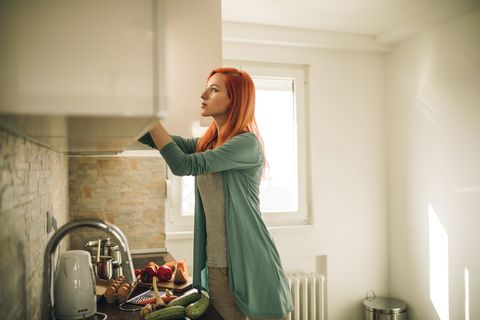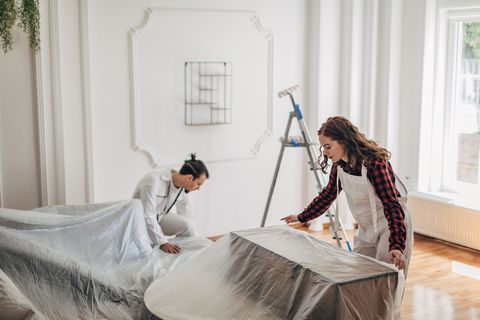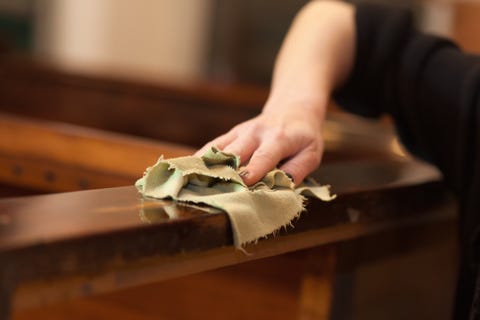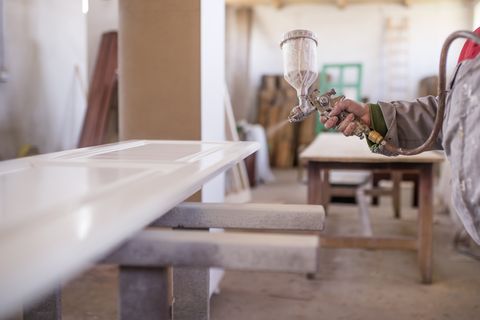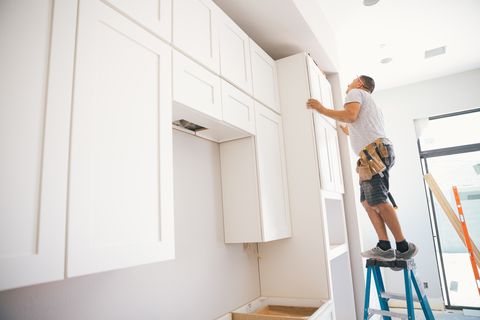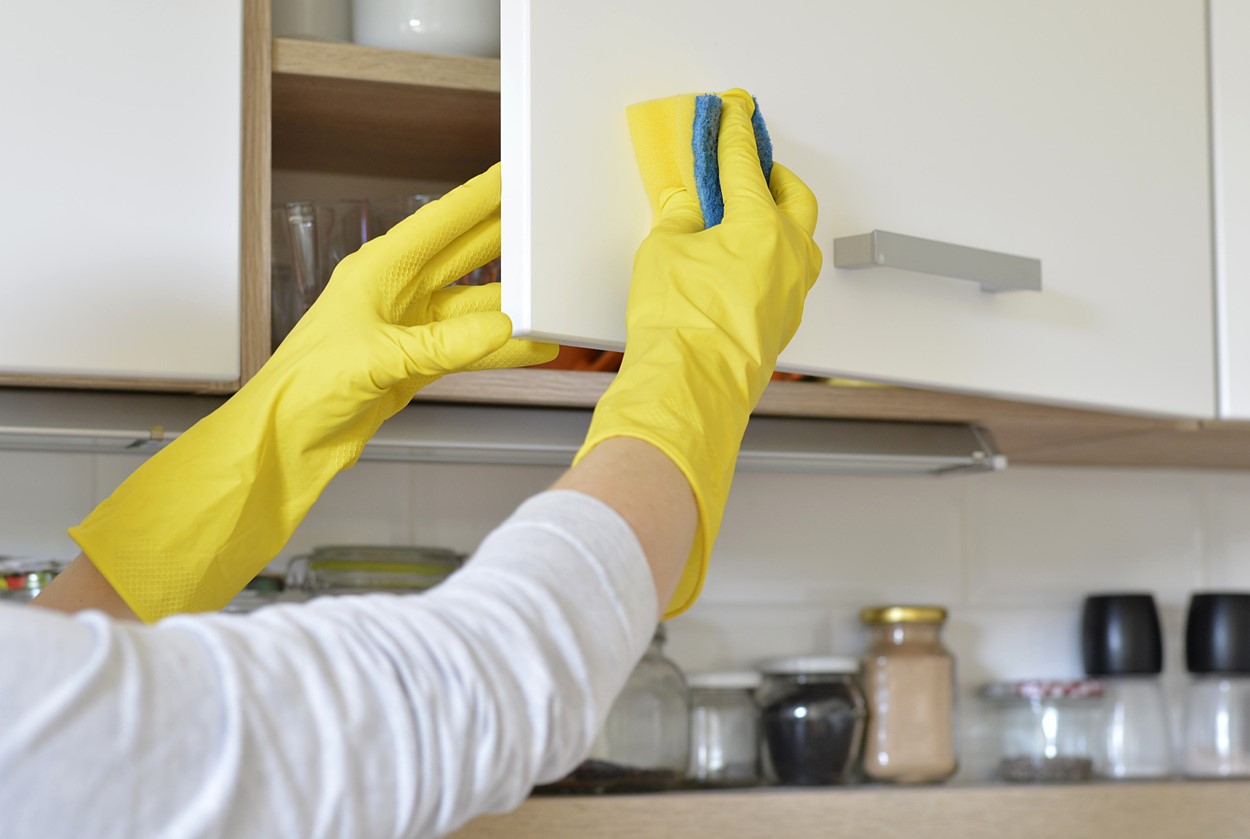If contemporary pop culture is any indication, we are currently obsessed with the home makeover. From shows like Queer Eye to Flip or Flop to The Home Edit, there’s something about that dramatic reveal of a renovated fixer-upper that has us at the edge of our to-be-reupholstered seats. We eat it up—on repeat (of course we’re still watching, Netflix). But there’s always one project that satisfies the collective desire for transformation above all others: freshly painted kitchen cabinets. “By painting cabinets, you are immediately creating a change that is noticeable without having to make a major investment in both time and money,” says Queer Eye star and design expert Bobby Berk. “And when you opt for a totally new color or one that creates more contrast, it just has this huge impact on how the room looks and feels.”
If you’re ready to go beyond reality television and go all Bobby Berk in your culinary space, here are some tips and tricks on how to paint kitchen cabinets like an expert, compliments of the pros.
Step 1: Consider Cost and Time
We’re not going to sugarcoat it: Tackling a kitchen cabinet paint job is not exactly something you can finish by noon on a Saturday. But tackling the project yourself does pay off—literally. A professional paint job can easily top $6,000 for an average kitchen, while doing it yourself can come in as low as $200 for paint and supplies. As for project length, a full kitchen takes six to seven days, so plan on a few nights of eating out.
“Anybody can do it,” says Renae Brabham, half of the husband-wife duo behind Brabhams Cabinet Painting in Charleston, South Carolina—together they’ve completed more than 500 kitchen cabinet jobs. “However, if you try to cut corners, then you’ll end up calling professionals to step in. We’ve gotten so many of those calls, and it almost always boils down to someone getting impatient or using bad products.” In other words, if you’re gonna do it, do it right. Now let’s get into it.
Step 2: Examine Your Cabinets
Rule number one: Before you break out the roller, take a look at the condition of what you’re working with.“Any small chips or cracks to the doors can also easily be repaired with a wood filler,” Berk says. But keep in mind, not all cabinet doors and drawers are paint-worthy. If the veneer is peeling or the woodwork is warped, you might be better off buying new unfinished drawer fronts and doors to replace the beat-up ones.
Cabinet material is also an important consideration. Wood, wood laminate, veneer, fiberboard, and even metal cabinets can be repainted without difficulty. However, plastic laminate and thermofoil cabinets might require special paints and techniques that will be more conducive to paint adhesion. If in doubt, test a sample of the paint in an inconspicuous area or even remove a door and bring it into a paint store for inspection.
Step 3: Prep the Space
We know, you’re eager to put brush to paint. But a little upfront prep ensures that your countertops and backsplash don’t get an unanticipated paint job of their own. Empty the cabinets, clear the counters, and move furniture that’s in the way, so you have plenty of work space. Give the room a thorough dusting to prevent particles such as pollen from settling on the wet paint. Next, cover the backsplash, counters, and floor with brown builder’s paper or plastic tarps.
Brabhams recommends preparing a work area outside of the kitchen—such as a garage or basement room—with good ventilation and even a few fans. There, you will lay down plastic and set up three to four sawhorses with two-by-fours on top to hold the cabinet doors. You can also set up a nearby paint station, complete with paint, rollers, brushes, buckets, and sandpaper.
When it comes to big paint jobs, don’t forget to take safety precautions to avoid unwanted exposure to paint vapors. Keep windows and doors open, use fans to keep the air moving, and continue ventilating the area for at least three days after painting. Take breaks while painting as well.
Step 4: Remove the Doors and Hardware
Yes, it’s a major time suck. And yes, you will be tempted to go rogue and skip this step. But removing the cabinet doors gives you access to all surfaces of the cabinet. So unless you are going for a bolder free-form flair, don’t cut this corner and do remove that door. Starting at one end of the kitchen (working clockwise or counterclockwise) use a drill or manual screwdriver to remove the cabinet hinges, doors, drawers, and hardware. If you’re painting only the door fronts, you do not need to remove the sides.
“Number the doors as you take them off,” Brabham advises. “Otherwise, it will be a mess because not all doors are created equal.” She suggests writing the number in the hole where the hardware was, and covering it up with a piece of tape to avoid painting over it. To avoid losing the hardware for each door, Brabham puts it on the shelf each door came on or placing each in a small bag that is labeled with the corresponding cabinet number.
Step 5: Apply Liquid Sandpaper
In the past, you had to clean, strip, sand, and generally break your back to prep a surface for paint. But the home improvement industry has evolved beyond soap and scrub brushes—and even sandpaper. There’s a product called M-1 Paint Gloss Remover (you can also use liquid sandpaper) that cleans and deglosses the surface. Sans sawdust. “This stuff is by no exaggeration a miracle product,” Brabham says. “Nobody sands cabinets anymore.” To use, wipe the M-1 gloss remover all over the cabinet doors—on the sides, across the top, on the back—and it will be dry in 20 minutes.
A word of warning: You never heard this from your mother, but we’re here to say, don’t clean the cabinets. “Cleaning solutions can be a huge culprit of our finest DIY horror stories,” Brabham says. If you use a TSP [trisodium phosphate] or a silicone-based cleaning product, you can get what’s called fisheye on your cabinets. “It looks just about as cringe-worthy as it sounds. This bubbly paint effect happens when the paint won’t stick, and it’s a nightmare because you have to let that dry, then sand it down, and at that point you’re lucky if you don’t have to take it to a professional.”
Step 6: Choose Your Paint and Application Tools
You’ve gone Pinterest happy on dream kitchen colors and you’ve maxxed out your phone storage space with apps to help you find the perfect paint shade. But you’ve now come to your moment of reckoning. While we can’t tell you what color to choose (Berk says green kitchen cabinets are his new obsession), a word on paint type (there are two main categories, latex and oil-based paint) might help with the decision process.
Whether you choose latex or oil-based paint, know that both provide a great finish. As latex paint has improved over the years, many pros have entirely given up on oil-based paints. “We used oil the first two years we were in business and quickly nixxed it because the latex products they have these days are heads above what they used to be,” Brabham says. Latex paints dry faster, are easier to clean up (requiring just water and dish soap), and are more forgiving than oil-based paints in terms of paint application. However, they can be more susceptible to stains and do take up to three weeks to fully cure (or subject your cabinets to daily use).
Oil-based paint, which is typically more expensive and less user-friendly, goes on smoother than water-based paint and tends to better hide the cabinet’s imperfections. It also shrinks less as it dries, which means that what it looks like wet is how it will look dry. “I prefer an oil-based paint for cabinetry that will be getting a lot of use, as it tends to hold up better over time,” Berk says.
Brabham recommends using the Benjamin Moore Styxx or Sherwin-Williams Extreme Bond as a primer, followed by the Sherwin-Williams Emerald urethane or Benjamin Moore Command paints—which are a hybrid of oil and urethane. “Both are extremely durable, have low VOC [volatile organic compounds], are not going to scratch, and don’t yellow like oil paint does,” she says. Pro tip: The average kitchen—about 25 doors and six drawers—requires one gallon of paint and one gallon of primer.
As for the finish, that’s one step you needn’t worry about, Brabham says. “You think about your sheen when you pick out the paint,” Brabham says. “Some are glossy, some are a more low luster finish, and others (the majority of our jobs) are semi-gloss, which offer a low luster look with a comfortable amount of protection.”
Your options for paint applicator tools include spraying or rolling. “Spraying cabinets is going to give you the cleanest and smoothest finish hands down, and is also much less time consuming than using a roller or brush,” Berk says. Though spraying can be pricey. The Graco Magnum Airless sprayer, the Apollo sprayer, or the Fuji sprayer are all great options. You could also opt for a professional-level sprayer, like the TriTech T4 sprayer, which some hardware stores offer for rent. If you’re intimidated by the idea of spraying your cabinets, rollers are always an option. Don’t forget to purchase a respirator mask to wear for protection against paint fumes.
Step 7: Apply Primer and Paint
Armed with the right tools, you’re ready to put paint to the surface. Prepare the sprayer or paint bucket, and begin with your first layer of primer. Start with the backs of each door, lining them up on the two-by-fours. Let those dry, then flip them over and spray the other side. “This is the part of the process where everybody gets scared, as that first layer of primer is going to look like something a six-year-old went to town on,” Brabham says. “Don’t panic. You’re just giving your cabinet a good base, and each layer gets progressively better.”
Once the primer has dried (a process that typically takes 40 minutes per layer), repeat this process with the paint. “The best way to build up the surface is with multiple layers of thin paint rather than one thick layer that can more easily chip off,” Brabham says.
If you’re using a brush and roller, dip the brush in the paint and apply it to the surface. Work your way from the inside edges of the face frames to the outer cabinet sides and fronts (this allows you to work quickly in the less critical areas and spend more time rolling over the flat surface while it’s wet). You will then go in with a flock foam mini roller and smooth it out. Be careful not to make too many brush strokes, which will create air bubbles that will dry into bumps. This is the same process you will apply to the cabinet base in the kitchen, as you can’t spray that.
Two coats of quality paint are usually sufficient, but a third coat can’t hurt. After the first coat of paint, lightly buff sand all the surfaces with an extremely soft sandpaper and wipe sanding dust with a tack cloth before going on to your next coat. Allow for at least four hours between coats. “Be patient as the cabinets dry,” Brabham says. “If you go to pick up the doors and they feel a little tacky, you’re going to leave fingerprints on them and have to redo the whole paint job.” Wait at least 48 hours so the cabinets can be fully cured before being reattached to the hardware and base.
Step 8: Put It All Back Together
Now you are ready to return everything to its proper place for the final reveal. Using the same drill or screwdriver, reattach the drawer fronts and doors to the hinges and hardware. Slide the drawers back in place.
Consider zhuzhing the newly painted cabinets with some stylish hardware. “Contrast is key when it comes to hardware,” says Berk. “For lighter cabinets, l like to go with darker hardware in black or bronze, and for darker tones I often opt for brass or nickel.” Add the bling and voilà: kitchen à la mode.
This content is created and maintained by a third party, and imported onto this page to help users provide their email addresses. You may be able to find more information about this and similar content at piano.io


